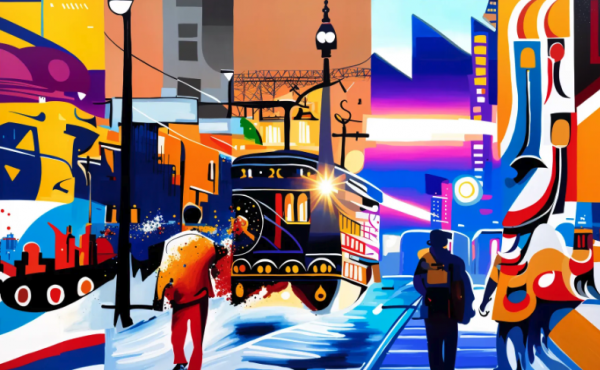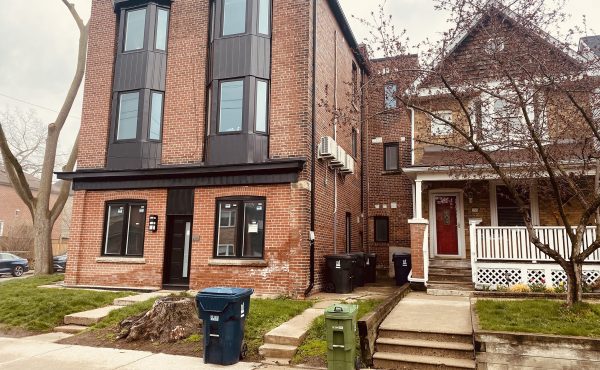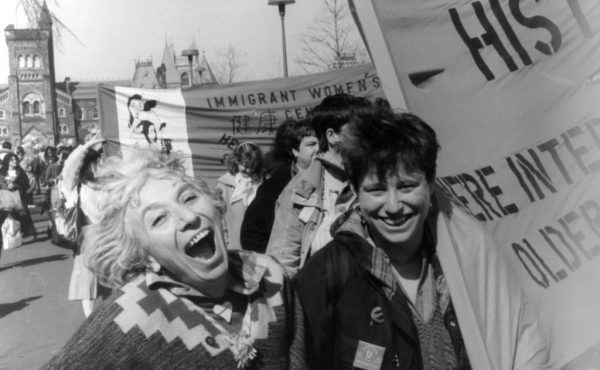 It’s June 16. After more than ten days of intense media coverage from all the major print, web, and broadcast media, Luminato has wrapped at last.
It’s June 16. After more than ten days of intense media coverage from all the major print, web, and broadcast media, Luminato has wrapped at last.
And you know what? I’m still confused about whether it was successful or unsuccessful, accessible or elitist, public fete or public failure. I headed out to events. I saw some public art. I read the coverage. I listened to my friends and acquaintances in the arts and urban advocacy community. (Including Matthew Hague, who did a great post on the Link boat earlier today.) And I still can’t tell.
Such confusion is exacerbated when fellow commentators like Martin Knelman—who I do think can have a lot of valuable things to say at times—reports that we needn’t worry about accessibility at LuminaTO because it has “143 events and 860,000 moments over 10 days, and more than 70 percent of them free.â€
Excuse me if we skipped this in my undergrad physics and stats classes, but I’m quite unclear on what a “moment†means statistically. One second? Ten? Must tears or laughter—or Kodak—be involved?
And this magic number of “860,000 moments‗where on earth did that come from? One second times 860,000 projected spectators/passerby? Do you count, as Luminato did on their events calendar, things like the CN Tower being lit up—which it is every night anyway—and people seeing that from the Gardiner? Or, um, not?
In a fit of being straight-up nerdy, I decided to come up with my own data using the “events by date†lists on the Luminato website. There I counted 96 free events out of 186 events total for the period of June 6 to 15. That’s 52 percent free.
But those free events did include the omnipresent CN Tower lights. And several panel discussions—the most dry form of entertainment known to mankind. And repeated days of public installations. Should I have counted those or not? What about if some really rocked—like the Regent Park pasteups—or sucked? Should they have been weighted more or less heavily?
What this little exercise highlighted for me (beyond my terminal geekitude) is that we need more genuine measures—qualitative, quantitative, or both—on how all our arts fests and institutions are doing.
These measures are most urgently needed on access and equity, where creative accounting gets most flamboyant.
But they are also needed on value-for-public-investment fronts too. This is particularly so when public provincial monies of $15-million were being handed out to one fest—Luminato—after it had already secured $7.5 mil for the three years of operation. Knelman argues that this “was not money that would have gone to other arts groups instead.”
But how does he know for sure? And what impact could those monies have had elsewhere? The $40 million that the Ontario Arts Council doled out in its last operating year funded 1,300 artists and 874 organizations in 252 communities across Ontario. And last year’s Nuit Blanche, while imperfect in its own right, provided 143 events, all free—for a couple mil.
Today, Luminato provided its summary press release on the fest, with the main quantitative improvement noted being an 8 percent rise in attendance at ticketed events. Even they must know that doesn’t come off as spectacular given all the ad money they sunk into the sophomore event. And they themselves might be hurting for some more accurate performance measures than the nattering of cheerleaders and critics on the sidelines.
So… what do you think a good arts access or success measurement tool could look like? I’m open to any that have been developed. (And anybody who can explain to me what a moment actually is.)




13 comments
Hrm. I am going to bet LuminaTO was more successful this year than last, and that it totally rocked in every way. Who disagrees?
To stay on the math trend, he actually meant (and I can’t believe this) that every second of the event was a “moment”.
So, 1 moment = 1 second.
The event was 10 days, so 10 days * 24 hours * 60 minutes * 60 seconds = 864,000.
So he rounded down a little, or maybe the event really was 400 seconds less than 10 days.
Martin Knelman is so in love with Luminato that I question his objectiveness. One would almost think he is paid by them judging by his gushing stories. I asked him about the fear in the arts community that Luminato is sucking the funding from other arts groups and he said their concerns were because they are jealous. You cant have your finger on the pulse if you spend all your time at the buffet table.
Ah yes, Luminato attendance. From today’s Globe we learn that the attendance “figure will settle near last year’s 1.03 million”.
However, we find in the next paragraph that “ninety per cent of visitors attended free events, but ticket sales rose 8 per cent after gripes that prices were too high last year”.
Now if I read that correctly, the paid attendance was only 10% of the total (say 100,000) and that went up by 8% (say from 92,000) last year.
Luminato needs to be a lot more than a bunch of street parties that screw up traffic downtown, and the ratio of artists and events drawing paid ticket sales (at even lower prices please considering the huge public subsidy) needs to go up.
So far, this festival doesn’t feel like part of Toronto to me, and cooking the stats don’t help improve its credibility.
86,000 moments a day does seem low for a city of 2.5 million, but the problem with a novel statistic like that is there’s no way to know what a good number would be.
I’d say the right way to measure this is the old-fashioned one: survey a bunch of people from their targets (some locals, some visitors). Did they attend? How many events and for how long? Would they go out of their way to attend next year? Would they recommend to friends?
I get the impression Luminato’s suffering from its split mission. The free public events are too few and too spread out to really be coherent: if you just show up to Luminato one day, it’s hit and miss and no one really knows what’s going on. But it’s the opposite problem for the ticketed events: there are too many trying to squeeze into a short run and worthwhile efforts don’t get the audience they deserve.
Ah, of course, 86,000 seconds a day! But the way Knelman writes it, it’s like he’s crediting Luminato with organizing the passage of time. Anyway, now we can say that the average person slept through 30% of Luminato’s moments — that seems fitting.
I visited the Harbourfront searchlights last year, but there was nothing the drew me this year–kind of like, “huh, is it on? huh, is it over?”
Nuit Blanche is much more concentrated, and it’s all free, and it has a real *event* feel to it. Plus conceptual art seems so much more conceptual and deep when you’re tired and it’s 4:30 AM. It also seems somehow way cooler. LuminaTO has the feel of an arts festival for boring people.
Hey Matt L, I agree that some targeted surveys should be in order… as they should be for other arts and cultural institutions, but aren’t. The American Association of Museums has a program where they will actually help assess a museum’s performance by surveying (gasp!) people who never attend the museum as well as those who do. It’s in surveying both that you get a more accurate picture of where a cultural event/institution is serving and not serving the public.
And Steve, I so agree on let’s reduce those ticket prices for next year, particularly at this massive level of public subsidy. Crazy, especially when it reaches the $100+ level, even $20 or $50, frankly.
Scott, I hear Knelman on a lot of people being jealous of this festival. That’s true for sure. But I agree with you that there are a lot of other factors–fairness, due process, political connections and their recompense–at play that Knelman has hugely overlooked by brushing it all off as “jealousy.”
Kevin, I do think the fest did some great stuff–like those Regent Park pasteups–but some other stuff, like the 80s celebration, was so-so. And I find it strange that the buzz was so silo’d in a way. I have some theatre pals who were out every night, and others (avid types) who had no clue on what was happening, who felt perplexed in that regard. That’s why some overall assessments are needed.
“I have some theatre pals who were out every night, and others (avid types) who had no clue on what was happening, who felt perplexed in that regard.”
They had a shit website.
There was only one thing that I was interested in going to, and I was using the website to pin down location and time. It was actually a navigational challenge to do something so simple. (I did manage to make it though).
Further, being on their site for that purpose should have brought to my attention other things that were going on, their time, place, and ticket price. But nothing registered.
And puhleas … ‘Great Canadian Songbook’ (I know someone who worked it) competed against the last Leonard Cohen concert. Lame … perfect for everything Laminato.
Anyway, this festival is really for boring old boomers.
A moment is 1.5 minutes in old English measurements. Although it fluctuated in medieval times between 1/40 of an hour and 1/50.
Rabbinical moments are way shorter. Like, split second territory. 5/114 of a sec.
Time for more math?
I can’t really saw if the whole thing was a success or not.
But I really enjoyed watching Nitin Sawney twice. That was very worthwhile.
Well I totally loved it, but then again, we did have two events as part of the festival.
What I do know, though, is that there were no bubble battles last year, and the dance party afterward was pretty epic, perhaps 800 people.
http://www.youtube.com/watch?v=E3-l1BdEV48
Is that video a measure of success? I think so 🙂
I had a good time. Post-partum is starting to wear off…twins are rough.
Here are some links to the first round of documentation and media from my projects (‘Livingspace’ at Regent Park and ‘Housepaint’ at the former tent city)
http://www.them.ca/housepaint-devonphotos/
http://www.them.ca/livingspace-workshops/
http://www.thestar.com/article/440848
http://www.woostercollective.com/2008/06/dan_bergeron_documents_the_residents_reg.html
http://www.canada.com/cityguides/toronto/story.html?id=24202e9a-8e9c-499b-885c-9e329830e074
http://www.theglobeandmail.com/servlet/story/RTGAM.20080531.wlumregent31/BNStory/luminato08/home
http://www.flickr.com/photos/patanne
http://p4design.blogspot.com/2008/06/streetscapeluminato.html